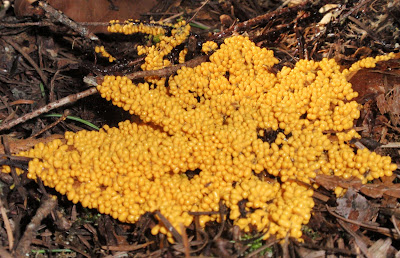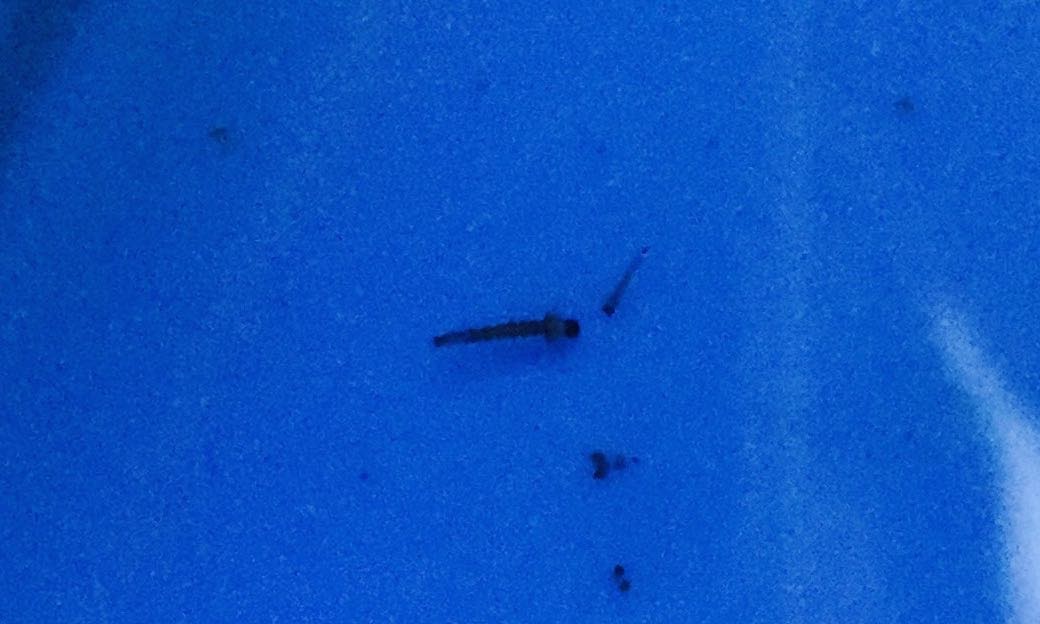I was walking the kids to the bus stop the other day and my eye was drawn to a bright orange mass of something on the ground. It's an area near several fir trees and a couple cedars and an old stump that has been colonized by ferns. There are a fair number of fir needles and small downed branches, bits of cedar debris, etc. It has not been "cleaned up" in any way other than to sweep organic debris from the road onto it.
Upon closer inspection the mass was made up of hundreds, possibly thousands, of little orange balls. My first slime mold. I was so pleased! I've been watching its progress the last couple days. Rather than migrating,
per se, it seems to be drying up and then a new colony sprouting up a foot or two away. This may have to do with our weather at the moment. Mornings are starting out quite "dewy" and cold (in the 40's Fahrenheit) and the afternoons have been sunny and dry (temperatures in the 60's). We've only had a small amount of rain in the last week.
My limited knowledge of slime molds tells me that these are the fruiting bodies, though when I punctured one with a pin, I didn't get dry spores like with some molds. These were creamy inside.
I'm having trouble figuring out what species this is. Some of the reading I've been doing gave me the name, "Common Orange Slime Mold" but not a scientific name. The early pictures don't resemble another common one,
Fuligo septica or "Dog Vomit Slime Mold", though a later one is a similar color. If any mycologists out there would like to chime in, I welcome your insight!
Here is the progression over the last several days:
 |
| This is how it looked when I first noticed it on the morning of the 29th of March. |
 |
| By the evening of the 29th, the balls had elongated and turned darker in color. |
 |
| Here, I've added a US penny to demonstrate the size. These are each millimeters in diameter. |
 |
| The next morning, March 30th, they were quite dry and starting to turn black at the tips. |
 |
| I skipped a day and then Monday, the 1st of April, went to check and the original colony (on the left) was nearly all black and a new colony had sprung up nearby (on the right). |
 |
| Close up of the new colony. |
 |
| Close up of the 'old' colony - mostly black, dry with a few of the fruiting bodies collapsed or broken open. |
 |
| 2nd April - The first colony is almost completely black, the second colony is going the same way - dry, orange ... |
 |
| ...and a 3rd colony has sprung up about a foot away. (Apologies that the photos aren't well-focused. The camera was not cooperating.) Quite a colorful picture with the fir needles and the lichen for contrast, if I do say so myself! |
In looking for information about the species I found a couple websites/blog posts about slime molds that I found helpful:
The Mushroom Expert
BTweenBlinks (Washington State)
WiseAcre Gardens (New York State)
UC Berkeley Museum of Paleontology --
Introduction to the Slime Molds
The Hidden Forest (New Zealand)
Tom Volk's
Fungi of the Month (Wisconsin)
 |
| Here is the 3rd colony this afternoon (3rd April) going the same way as the others. No new colonies have appeared. |
On the 4th of April it started raining again after 6 days of mostly sunny and dry conditions. When I checked the slime mold this morning (5th April), I struggled to find the first two colonies - they pretty much blended in with the rest of the detritus. The 3rd one also was quite black and the individual nodules had shrunk. About a meter away, however, there was a small new colony. It was on a brown leaf, dropped from a big leaf maple. This one had veins! My nerdy biologist self giggled with glee at the flowing protoplasm:
 |
| "Flowing" slime mold forming a new colony with a baby slug added for interest. |
































